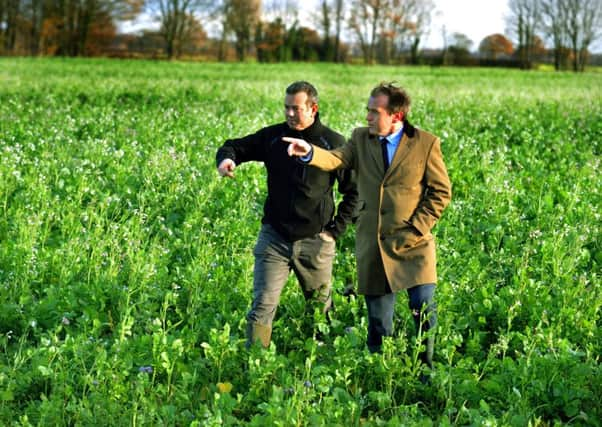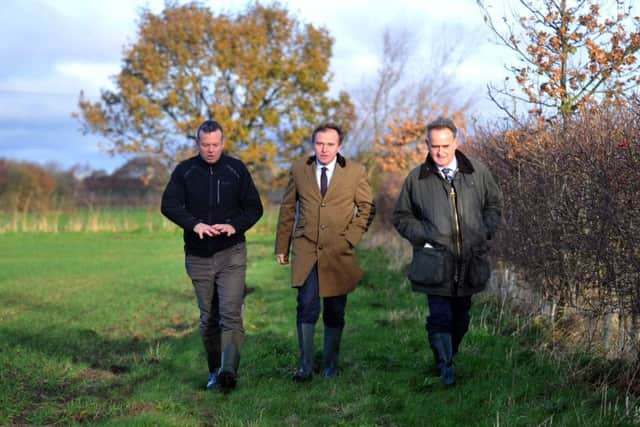Minister explains simplified farm nature schemes during Yorkshire visit


During a visit to a farm near York, Mr Eustice revealed details of a “simplified” Countryside Stewardship scheme for 2019 which will involve half as much paperwork as its predecessor.
Farmers can apply to join the scheme in January next year and the Minister said he hoped far more farmers would sign up than the 5,000 or so in England who joined last year’s scheme.
Advertisement
Hide AdAdvertisement
Hide AdThe existing scheme, developed by the Government in accordance with strict European Union rules, has been criticised for being overly bureaucratic and, with 70 different options to choose from, overly complicated.


On Tuesday, Environment Secretary Michael Gove admitted that both the Department for the Environment, Food and Rural Affairs (Defra) and Natural England, had been “dreadful” at seeing to the smooth functioning of stewardship schemes, with some farmers hit by delayed payments.
Speaking earlier today, Mr Eustice agreed that the revised scheme design was “recognition that we didn’t get things right first time round”.
He told The Yorkshire Post: “We want more farmers to be going into these schemes, so what we have launched today is a new countryside stewardship offer, a simplified set of packages: one for arable farms, one for mixed farms, one for upland farms and one for lowland grazing farms.
Advertisement
Hide AdAdvertisement
Hide Ad“You can get an agreement doing as few as three options and we have split them into a menu of three different categories. We have picked the options that deliver most and which are most popular. This will be a much simpler process and crucially so much easier for Natural England to administer.”


Mr Eustice explained that the new Countryside Stewardship scheme is “a building block for farmers going into future policy”.
“Michael Gove has been very clear that we want a new agri-environment scheme to be the cornerstone of our future policy and I think farmers that enter this new countryside stewardship, this simplified offer, will find that they are in the right place for future policy to come,” he said.
The Minister was at Richard Bramley’s 500-acre Manor Farm in Kelfield, an arable operation where wheat is grown for bread-making and vegetables such as potatoes are harvested.
Advertisement
Hide AdAdvertisement
Hide AdMr Bramley’s on-farm environmental measures have boosted wildlife and soil quality. Around 90 bird species, including many of conservation concern, have been recorded at the farm where a 19 percent increase in species has been seen during the farmer’s ten-year involvement in previous entry level stewardship schemes.
Having been put off from joining the current complicated replacement scheme after EU Common Agricultural Policy (CAP) reforms in 2015, Mr Bramley is just the sort of farmer who Mr Eustice hopes will sign up to a far simpler scheme.
Mr Bramley said: “It is good that there is now a further opportunity for farmers to access funding for work on stewardship as many were disenfranchised following 2015 CAP reform and the ending of the previous schemes.
“The new scheme offer seems much simpler to both apply for and manage, whilst still recognising the public benefits that stewardship brings.”
WILDLIFE STANDS TO REAP THE BENEFITS
Advertisement
Hide AdAdvertisement
Hide AdMr Eustice said there are clear benefits to the environment and therefore to productive farming of Countryside Stewardship schemes, particularly if they function effectively.
He said: “There is a real connection between our soil health and water quality and if we get some of these fundamentals right we can really start to reverse the fortunes of our wildlife and our natural environment and see things improving.”
Agreements with farmers under the new scheme will run for five years. Options include planting nectar flower mixes, adding buffer strips to fields and hedgerow management.
Both the existing mid and higher tier countryside stewardship schemes will remain as “more ambitious” options for farmers, the Minister said.